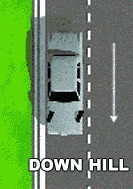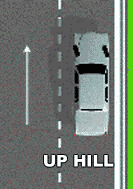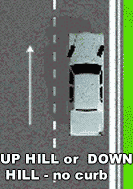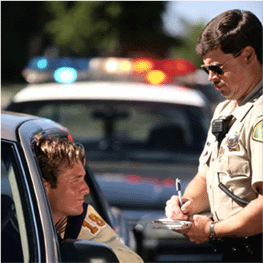Cal-Driver-Ed.Com |
|
California's Home Study Driver Education Class |
To easily find this site again, hit Ctrl+D, or drag this link: Cal-Driver-Ed to your Favorites.
| Log-In | Driver Education | Driver Training | DMV Requirements | FAQs | Compare | Contact Us |
|
The California DMV Driver Handbook |
|||
When you park headed downhill, turn your front wheels into the curb or toward the side of the road. Set the parking brake. When you park headed uphill, turn your front wheels away from the curb and let your vehicle roll back a few inches until the rear of one front wheel gently touches the curb. Then set the parking brake. For either uphill or downhill parking, if there is no curb, turn the wheels toward the side of the road so the car will roll away from the center of the road if the brakes fail. When you park on a sloping driveway, turn the wheels so that the car will not roll into the street if the brakes fail. Always set your parking brake. Leave the vehicle in gear. Use the “parking” position if your vehicle has an automatic transmission.
A painted colored curb means that you must follow special parking rules. The colors on curbs mean: White: Stop only long enough to pick up or drop off passengers or mail. (Usually at airport passenger terminals.) Green: Park for a limited time. The time is usually shown on a sign next to the green zone, or painted on the curb. Yellow: Stop here only long enough to load or unload passengers or freight—no longer than posted. Drivers of noncommercial vehicles are usually required to stay with their vehicle. Red: No stopping, standing, or parking. (A bus may stop at a red zone marked for buses.) Blue: Parking for the disabled only. You must have a disabled person parking placard (window sign) or disabled person or disabled veteran license plates.
This blue symbol also marks parking spaces and special areas for disabled people. Disabled persons may apply for the special plates and/or a parking placard at any DMV office. With these plates or a placard, disabled people may park in special areas. No one else may park there. Holders of disabled person plates or placards may park for unlimited periods of time in parking spaces where a sign indicates a restricted time. NOTE: Placard abuse results in cancellation or revocation of the placard and the loss of special parking privileges. Placard abuse is a misdemeanor and is punishable by a fine of $250 to $1000, imprisonment in county jail for up to six months, or both. Never park or leave your vehicle where it will block traffic. For example:
If you must stop on a highway, park completely off the pavement. You must leave enough space for other vehicles to pass freely. Your car should be visible 200 feet in each direction. A vehicle that is stopped, parked, or left standing on a freeway (even if disabled) for more than four hours may be removed (Vehicle Code [ VC] §22651 [f]) . • When you park alongside a curb, the front and back wheels must be parallel and within 18 inches of the curb. If there is no curb, park parallel to the street. (VC §22502[a]) . • Never leave your car until you have stopped the engine and set the parking brake. • Don’t open your door on the traffic side unless it is safe and doesn’t interfere with traffic. Look for passing bicycles and motorcycles. Do not leave the door open any longer than is necessary to load or unload passengers. |
26 27 28 29 30 31 32 33 34 35 36 37 38 39 40 41 42 43 44 45 46 47 48 49 50 Glossary
|
Our Driver Education Course is Accepted by the California DMV View Our California DMV Verification Letter Sample DMV Driver Education Certificate of Completion  "Cal-Driver-Ed is a pioneer in the field of online driver education. Over 80,000 California teenagers have taken their courses and are driving today." "I recommend Cal-Driver-Ed for home study driver education." The following quotes are excerpts from a California DMV Study on the Effectiveness of Home-Study Driver Education (PDF) dated April 2003: "Home-study students performed just as well or better than classroom students ... " "Home-study courses may also have the additional benefit of increasing parental involvement in their teen's learning process, which has been shown to be an important factor ..." |
|
Cal Driver Ed is proud
|
|
Already Have Your License? Traffic school will help keep your auto insurance costs lower if you receive a traffic ticket. Every licensed California Driver must have auto insurance to drive a vehicle in California. Proof of insurance must be provided to the California DMV when you obtain your drivers license (not your learners permit). Proof of auto insurance must also be provided to DMV when you register or renew the license on a vehicle you own. |






